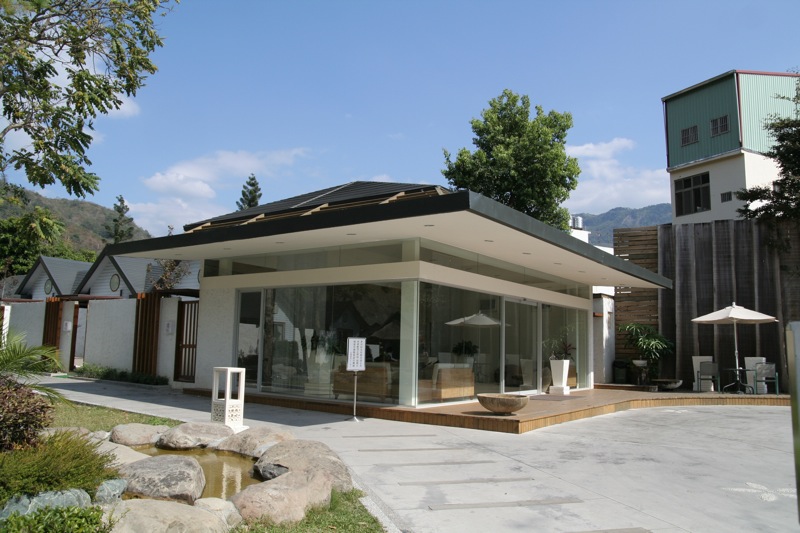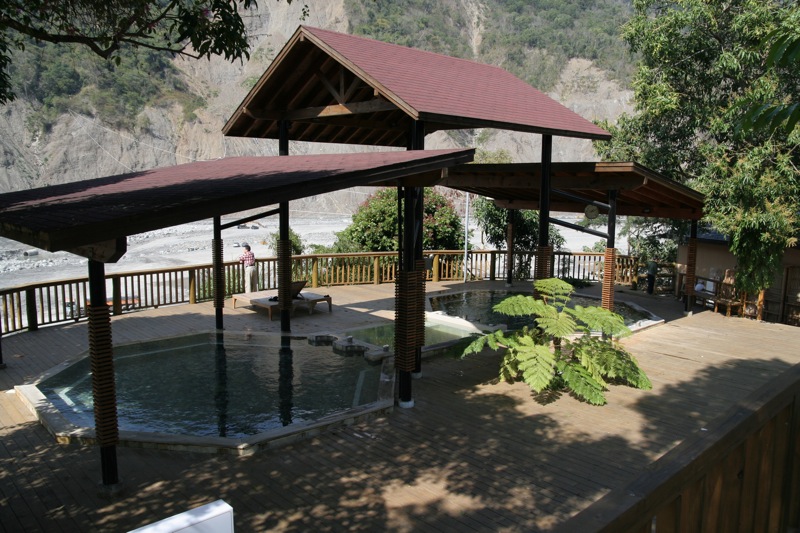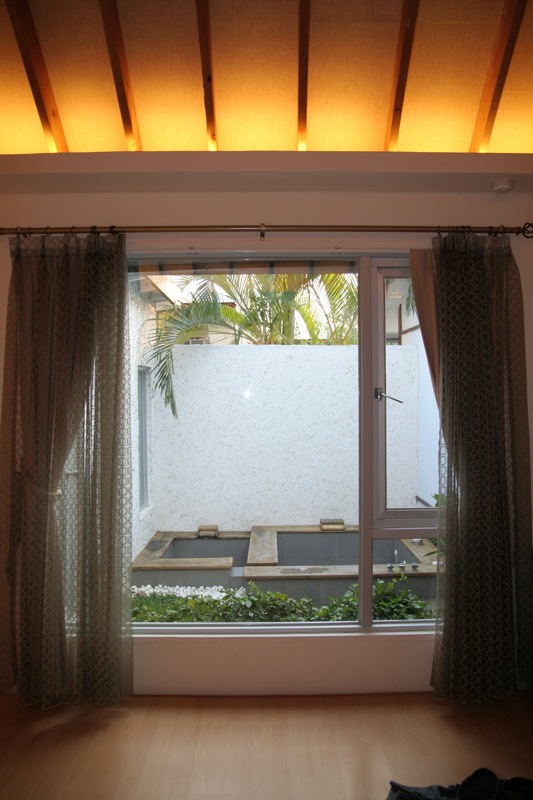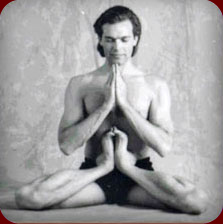瑜伽有一個開始,但不會結束。---Geeta Iyengar
後彎體式按摩腎上腺,使兒茶酚胺(兒茶酚胺catecholamines包括腎上腺素、去甲腎上腺素和多巴胺,這裏主要指前兩者)的分泌大量增加,因此讓我們感到精力充沛。
從人的情緒生理學上來說,這些成分在血液中濃度的增加可以讓我們振作起來,或者說興奮起來,情緒高昂起來。
前曲體式能使人安寧下來,因爲前曲體式帶來臣服的心理感受。即使是深度的前曲體式也是冷卻安神的。
比較起來,後彎體式是外向型的,前曲體式呢,則比較“內向”。
在做每個體式的時候,當你完成了初步的肢體移動之後,你就應該開始對一些深層的協調性的方面進行調整。有時候,一個體式本身可能已經很有挑戰性,因此你無法再對身體的其他單獨部分作細小的調整。這時,你就需要運用一些輔助物來減少體式的難度,以便對身體其他部位作細小的調整。
Iyengar先生對瑜伽的最大貢獻之一,就是他對體式修飾的細節研究以及對輔助物的精細摸索。 當你能夠自如地結合種種細節調整之後,你就可以將具體體式的挑戰性內容一起統一起來鍛煉了,這時你可以不再需要輔助物的幫助而完成整體的體式。
運用跳躍的方式進入和結束一個體式,對站立體式來說,是比較傳統的鍛煉方法。如果你採用這樣的跳躍方式,記住,每次跳開或者合攏的時候,保持身心的輕盈和鎮定自若。跳躍幫助你在站立體式中保持身體兩側的平衡,這點你需要在鍛煉中去仔細體會和理解。當你跳著分開雙腿的時候,注意,動作應該從你身體的後側(軀幹、手臂、腿)開始引導(注意力和發力從身體背面開始),而不是身體的前面。(這裏似乎有陰陽的影子)
必須在每個體式中延伸你的脊柱。不要過度壓迫身體的前側(尤其腹部和胸部),尤其是在鍛煉前曲體式時,否則會影響深呼吸。在伸展身體前側的同時,也要伸展脖子的後側。在任何體式中都不應縮短頸項後側,即使是在最厲害的後彎體式中。
任何一個體式的鍛煉,不管身體的哪個部位落在地面上,注意,用力壓入地面,就像試圖和地面融合在一起。比如做駱駝式的時候,兩小腿的前側,下犬式時的兩手和兩腳,都應作如是練習。
在絕大多數體式中,請保持自然呼吸(儘管在有些體式鍛煉中會不可避免地對呼吸造成一些困難,比如膝碰耳犁式Karnapidasana)。

Karnapidasana
當你在做一個頗具挑戰性的體式時,你總會有屏息的傾向。這時候,應該提醒自己,保持自然呼吸。吸氣,延伸脊柱;呼氣,推動體式的進一步深入。總體而言,在你結束一個體式,從中出來的時候,應由吸氣來完成。
體式鍛煉開始之前,請盡可能保持消化道的空虛。要具體規定你在進食後多長時間才能鍛煉體式,這幾乎是不可能的。因爲這有賴於你進食的量、食物的種類以及個人的消化能力(消化速度)。
保持深層的謙卑,這將有助於你的瑜伽學習。請記住,沒有任何一種途徑或者一個派系可以壟斷真理,這點很重要。即使是每一個派系中,也總是有優秀的習練者和平庸的習練者之分。要想在瑜伽習練之途中走向成熟,必須學習尊重別人的途徑,承認別人的長處;有時甚至需要承認自己所選途徑在某些方面的不足而其他途徑(在那些方面)則可能更好。
多應用技能,而減少精力消耗。如果你僅僅是費勁地撐住一個體式而不能存在於一個體式之中,那就請你從那個體式中出來吧。跳躍能製造身心的輕快愉悅感。吸氣,跳進一個體式。不過,如果你有低血壓,那樣的話,就應該呼氣跳躍。吸氣,向上;呼氣,往下。幾乎所有協調性的動作都是由呼氣來啓動的。支撐物和輔助物的使用並不是爲了讓你放鬆,也不是讓你用懶散的方式去做一個體式。它們是爲了讓你能夠從內在去感受一個正確的體式作帶來的感覺,從而我們能夠提升自己。
在幫助每一個習練者打開能量流通的新通道的過程中,輔助物可以起到非常重要的作用。在你做一個體式的時候,即使是一個很簡單的肩倒立變式,如果你的手或者手臂感受到有輕微的刺痛,那也都不是好的迹象。這時你已經過於拉伸手臂了,你需要減少你用力的程度。
“酸疼難以避免,痛苦則不”。
對初學者來說,我們在一個體式中保持的時間比較短,因爲我們的耐力還比較低,我們還處在學習基本體式形態的階段。當我們取得進步了以後,我們就可以在一個體式中保持時間長一些,因爲我們已經掌握了體式的基礎。這時,我們就可以開始去做並體會體式中那些細緻的調整動作,去用力體會我們在身體某部分的每個細微調節對其他各部分的影響,體會那個細微調整對體式整體的影響。
在每個體式中,應該像在挺屍式中那樣,放鬆臉部。
必須在所有體式中去尋找活動和穩定之間的平衡。
只是去做一個瑜伽體式是很簡單很容易的,但是要在一個體式中去感受、去領會、去探究,卻困難得多。
在瑜伽體式鍛煉中,可以應用“動靜結合方法”(Vilomna Method)----製造動作,暫停下來消化吸收一下剛才的動作效應(同時可以稍微放鬆一點),接著如果感覺對了就再製造一下前面的動作,如果感覺不對的話,當然你就收回來(不做那個同樣的動作)。
扭轉常常是比較容易讓人氣餒的體式,尤其是那些做起來讓我們覺得自己某些部分太胖或者太硬的體式,更容易讓我們情感上受傷。扭轉體式是富具挑戰性的,因爲你沒有一個可以參考的固定的點可以讓你的身體有個依靠和參照因此獲得成就後的滿足感。這就不像手倒立中跳起雙腿以及站立前曲中把手置於地面那樣簡單易於操作(因爲你知道終點在哪里)。我們通常總是覺得還有不少的空間可以扭過去,這在情感上會給人以“無所依”的困惑。
 Urdhva Prasarita Padasana
Urdhva Prasarita Padasana
在一些需要努力使勁的體式中,比如上伸腿式(Urdhva Prasarita Padasana,仰臥手臂向後貼地置於頭後方,擡腿),你必須誠實地面對自己的能力。如果你在並非真正需要停下時你停下來,你在欺騙你自己。如果相反,你真正需要停下來時卻不停下來,你也是在欺騙你自己或者你甚至可能正在傷害你自己。
當你在做大難度的體式時,請時時檢查自己的這些部位是否保持放鬆和柔軟:你的舌頭、眼睛、以及臉部的肌肉。
對你身體能夠做到的表示感激,但是不要對它所不能做到的表示失望。
後彎體式是強有力的情緒治療者,是處理失落和沮喪情緒很有幫助的方法。
在瑜伽鍛煉中,不像你鋪好了床,就一定要躺上去----你總是可以從新鋪床的(沒有固定的程式,你總是可以重來)。
在有時候,你需要停下來,不再繼續對體式中的一些動作進行深化(如不再在柔韌性上努力),這時你需要在體式的其他方面進行調整。在無論哪一個體式中,如果你感覺到了頸部以上區域的緊張,注意,那是浪費能量的行爲。
任何時候,在你拉伸大腿後部區域時注意你也務必同時加入拉伸股四頭肌(提起膝蓋骨)--這將幫助你更好地鬆開大腿的後部以及膝蓋後面的肌腱。
體式的精神(the spirit of pose)比你的“自我”(ego)更爲重要,因此,需要的時候就使用合適的輔助物,或者簡化或者調節體式。。即使在很困難的體式中也要注意培養那種內心的寧靜。
如果你不能很好地進入一個的體式,不能將體式做的和諧愉快,那麽應該從體式中出來,加以調整,不要就那麽呆著。我們常說不要在周圍治安狀況不良的地方閒逛,瑜伽體式也是如此。在身體其他部分不能保持和諧良好的情形下,你也不要在那裏浪費時間。
也應該多關注整個體式對你的身心帶來的效果,並和其他體式進行比較。不要成爲一個技術崇拜者,要用心去感覺和體會。
在每一個體式中,請注意,每一個身體部位都有它的職責。身體其他部位正在勤奮工作時,不要讓身體的某個部位鬆弛賦閑。你知道一個體式的形狀,但你的身體接受了嗎?吸氣,跳開兩腿以支撐腹部和腰部的器官。但懷孕期間不要跳,如果你有膝蓋以及下背部問題的話,也不要跳。
什麽是僵硬?什麽是靈活?什麽是輕快?什麽是沈重?什麽是緊繃?什麽是柔和?嘗試做點努力去完成所有的調整。不必爲了讓自己舒服點而搖擺不停,那樣將影響你讓自己完全呈現於當下的體式之中。
如果在一個體式中,你感覺有些煩躁不安,那麽問一下自己:我是否在做一個合適的調整,還是僅僅爲了避免隨體式帶來的不適?
在馬戲團裏,他們也作雙手平衡姿勢(比如手倒立)。馬戲團裏的做法和瑜伽裏的做法,這兩者之間有什麽不同嗎?
區別在於在瑜伽中講究身體協調的體驗,在於身體每個部分連接爲一個整體的感覺,以及對身體每個部位的細緻覺知:即使是小腳趾,體會一下小腳趾的感受以及在整個體式中的作用。
放鬆臉部,喉嚨,頸後部,還有你的頭腦;放鬆它們,即使你正在保持一個難度很大的體式。在一個體式中,我們常常不能保持那種對當下的專注。很自然地,我們傾向於想要把我們自己“放”到一個體式中,並且保持在那裏。在進入一個體式一會之後,觀察一下你的意識;你或許能注意到你的意識是怎樣從它應該做的事(即感知身體部位的調整)中漂移到別的事情上去,比如它也許會想:
“教練已經讓我們在這裏保持太久了”
“下一個體式要做什麽?”
“我的瑜伽墊歪了”等等等等。
每一個體式都是用力和放鬆的組合。在每個體式之後,請暫停片刻,反思一下體式給你帶來的身心變化。
即便隨著你年齡的增長肉體走向衰老,瑜伽也是屬於少數你可以不斷提高越來越好的事情之一。即使在他70多歲80多歲時,Iyengar先生的體式做得比他早年的更好。
在幾乎所有的體式中,旋轉你的肩胛向後,尤其肩胛骨的下部應該壓向前。應該提高並旋起兩側腋窩旁的胸部。
讓你的身體和意識接受並融合到一個新的模式中的唯一途徑,只有不斷重復並持之以恒的練習。
NOTE:
1.轉載自聞風老師的網誌
http://blog.sina.com.cn/u/1266249227
(上文譯自BRAD'S IYENGAR YOGA NOTEBOOK
http://www.bradpriddy.com/yoga/
,並結合了本人[聞風老師]的鍛煉經驗體會。)
2.提供英文原文給大家參考且提昇英文能力
(Yoga是世界性的,不提昇英文無法走出台灣)
Brad's Iyengar Yoga Notebook
General principles for all asanas
"Yoga has a beginning, but no end." -- Geeta Iyengar
Yoga is not an exercise; it is an exploration. The yogasanas are not static poses, but a changing dialogue with your body that is different every day. Yoga is not so much a means to achieve some outcome like flexibility or health as it is a lifelong path of deepening the "intelligence" of your body, to use Mr. Iyengar's parlance.
In each asana, one goal we are working toward is achieving some amount of "effortlessness within effort." This comes about in part from proper alignment allowing your body to support itself more and more on its skeletal structure than with muscular effort, and also through a type of somatic memory gained through repetition. It is always good to ask yourself when you are holding an asana what muscular effort you can dispense with and still hold the posture intact. Eliminate unnecessary physical effort. Do not be static in any asana -- feel where you are and do something. Constantly be feeling where your "edges" are and trying to push them back softly. In each pose, keep searching for a better, more effortless place.
Every person's body is different. Some individuals will always be less flexible than others. Having less flexibility does not preclude a person from becoming an advanced yoga practitioner. The most important flexibility is mental and emotional flexibility. Physically, the question is, can you perform the necessary actions and alignments for you to be able to breathe deeply in the asana, and perform it with increasingly less effort?
We all live in a little box called our "body." How tight our hamstrings or calves are is just one of the edges of our box. Yoga practice allows us to push back all the edges of our box so that we get to live a little more freely, with more of a feeling of ease, like living in a bigger box everyday. The asanas are designed to have both a physical and mental effect and their effect does not depend in the slightest on how deeply you can bend your torso forward in Pascimottanasana or whether you can touch your toes in Uttanasana. When you practice yoga, somewhere along the way you touch your toes, but that's just one arbitrary point in a whole lifetime of pushing back the edges of your box and it doesn't stand out there as a real "goal" to achieve or anything all that significant. The important aspect of yoga practice is receiving the benefits of the asanas in small daily doses over years.
Mere contortionism is not yoga if it is done without extending intelligence to every body part and surface, or if it is devoid of a spiritual aspect. What makes something yoga is not so much what is done, but how it is done and what the effect of doing it is.
The subtle details of asana alignments can be so numerous as to make concentrating on many of them at once nearly impossible. Fortunately that is neither necessary nor advisable. It is perfectly reasonable to take certain alignments to focus on during a given session while giving less conscious attention to others. Through repetition and maturity of practice, as our cellular learning deepens and our awareness expands throughout the body, many of the alignments occur more or less spontaneously or habitually without conscious thought.
Never rush into your deepest pose all at once. Move slowly and gradually to your deepest position. As you begin to move into an asana, feel for the first place of tension or "edge" that you come to. Pause at that place, and relax into that edge. Clarify your posture, and wait for the sensations of stretch, pain, or tension to fall away somewhat. Then move into the pose deeper until you find a new "edge." Pause again, breathe. Repeat this process over and over until you reach the final edge for that pose for that particular day, when the sensations of tension no longer release with sufficient waiting.
After you have made all the adjustments and actions you know how to make in a given asana, then the practice of that asana begins. You need to remain in the pose for a length of time before coming out, allowing each edge to soften. Resist the temptation to come right out of the asana when you have finished making all the adjustments you know to make. Hold the position and wait for the inner cue to know it is time to come out of the asana. There is no final edge or final posture. New edges always appear.
It is somewhat superfluous to try to recommend certain lengths of time to stay in each posture. The amount of time you should spend in an asana will vary based on your experience, level of practice, level of energy on a given day, difficulty of the particular asana, and personal constitution. While 30 seconds in Adho Mukha Svanasana may be all one individual can do, another will find 5 minutes suits their disposition on a given day. While you should aim for an overall lengthening of the amount of time you spend in each asana, trying to recommend a number of seconds or minutes that will fit everyone is impossible. Stay in each pose as long as it feels integrated, solid, maybe sublime, and then move on to another pose when that quality fades. That is to say, stay in a pose until you lose equanimity or peacefulness in the pose.
This does not mean that you give up early because an asana is difficult or uncomfortable for you, only that you do not carry on unnecessarily long in a posture in which you have lost somatic attention or are no longer able to extend your intelligence to each body part evenly and clearly.
The importance of the standing poses is often neglected.
The standing poses develop leg and hip strength and flexibility, increasing pelvic mobility. The standing poses are not a hazing ritual for beginners, but rather the safest and best method for increasing leg (especially hamstring) flexibility required by the seated forward bends and other poses. If your hamstrings are tight, their pull keeps your pelvis from rotating forward over toward your thighs freely which will inhibit all forward bends. Attempting to do Padmasana with tight hips which do not externally rotate fully is asking for knee injury. You should not attempt Padmasana until you have adequate hip flexibility as measured, for example, by your knees being close to the floor in Sukhasana and Baddhakonasana. This hamstring and hip flexibility is cultivated mainly by the practice of the standing asanas (although there are also other asanas that are helpful).
Classically we begin each asana on the right side. Do your "bad" or less flexible side of a pose longer than your good side to even your body out from side to side. As your somatic intelligence increases, you will almost always feel that one side of your body is better in a given asana than the other side. Seek to equalize your two sides. As Mr. Iyengar has said, when one side of the body is doing better than the other side, the first side has to become the "guru" of the other side. If some body part is sore from yesterday's practice, it is good to work that area with the same pose again today, starting light. You will have to bear a little discomfort in order to learn yoga, as nothing can be learned with complete comfort. However the object of yoga practice is not to cause pain, but to relieve it and more importantly prevent it.
Incorporating good postural habits into your daily routine will pay dividends in your yoga practice and vice versa. When sitting in a chair, whenever possible fold your legs up and sit in Sukhasana or Ardha Padmasana. Sitting cross-legged in a chair, or cross-legged on the floor as much as possible will help to keep your hip flexors supple to aid in hip flexibility. Make sure you are sitting on the front edges of your sitting bones, not the rear sides or even worse, back on your gluteal muscles and flesh. Sitting back onto your tailbone (sacrum) causes your pelvis to tuck under, your low back to round, and your chest to collapse. Lengthen the front of your torso when sitting. Raise your sternum toward the ceiling. If your feet are on the floor, sit on the front part of the chair, keeping the normal concave lumbar curve (lordosis).
Allow your shoulders to fall naturally down away from your ears. It is fine to use the back of the chair for support if you use it properly, with your buttocks at the back of the chair and an arch, the normal lumbar lordosis, rather than a rounding in your lower back.
Many chairs force us to sit with our thighs level, or even worse, with our knees higher than our hips. For most people, this causes the pelvis to tilt backward and the lower back to lose its natural concavity.
Sit on a towel or pillow to elevate your pelvis if this is happening to you.
Backbends massage the adrenal glands and energize us with a surge of catecholamines. They are emotionally uplifting.
Forward bends are calming. They are poses of surrender.
Even the deepest forward bend should be cooling. Backbends are poses of extroversion. Forward bends are poses of introspection.
Once you have the gross movements of an asana achieved, you should begin to work on the more subtle actions.
Sometimes, an asana may be too challenging as a whole unit to allow working on the small actions of individual body parts. In this case, you may need to use props or modify the pose to remove some of the challenges and allow you to work on individual small actions. One of the great gifts of Mr. Iyengar to yoga is his detailed use of props and asana modifications.
Once you integrate these small individual actions, you can restore the pose to its complete form without props to practice the inherent challenges of the pose as a whole.
Jumping your feet apart and together is the classical method for entering and coming out of the standing poses. If you choose to do it, you must do it lightly and with poise. Jumping helps to open and resolve the standing poses symmetrically in a way that must be experienced to be understood. When you are jumping your legs apart, make the action occur from the back of your body, arms, and legs, not the front side.
Extend your spine in every pose. Do not compress the front of your body, especially in the forward bends. This inhibits deep breathing. As you lengthen the front of your torso, also lengthen the back of your neck. Do not shorten the back of your neck in any asana, even in the deepest backbend.
In any asana, whatever body part is on the floor, press it into the floor; merge it with the floor. This includes, for example, your shins in Ustrasana and your hands and feet in Adho Mukha Svanasana.
Your breath should be natural in most asanas (although some asanas like Karnapidasana will inevitably cause some restriction in breathing). There is always a tendency to hold the breath when trying to get into a challenging position.
Remind yourself in each asana to breathe.
Inhalation is the time to lengthen your spine, exhalation is the time to make further progress in the pose.
In general, when coming out of an asana, you should inhale as you come out.
Keep your digestive system as empty as possible before an asana session. It is really impossible to specify a certain number of hours you need to wait after eating before practicing since that will vary widely with the size of the meal and your own digestive speed.
A deep sense of humility will help you learn yoga.
It is important to remember that no one path or school has a monopoly on the truth. There are excellent and poor practitioners in all schools of yoga.
Gaining maturity in yoga practice involves learning to respect the paths that other people are on and acknowledging their merits, maybe even acknowledging that your own path is lacking in some area where another one excels.
http://www.bradpriddy.com/yoga/gen.htm
 Padangusthasana
Padangusthasana










 YouTube創辦人陳士駿宣布台灣版上線,現場請來三太子跳舞、戴墨鏡造勢,展現網路傳統和自由並陳的特質。記者陳柏亨/攝影
YouTube創辦人陳士駿宣布台灣版上線,現場請來三太子跳舞、戴墨鏡造勢,展現網路傳統和自由並陳的特質。記者陳柏亨/攝影 Karnapidasana
Karnapidasana Urdhva Prasarita Padasana
Urdhva Prasarita Padasana







